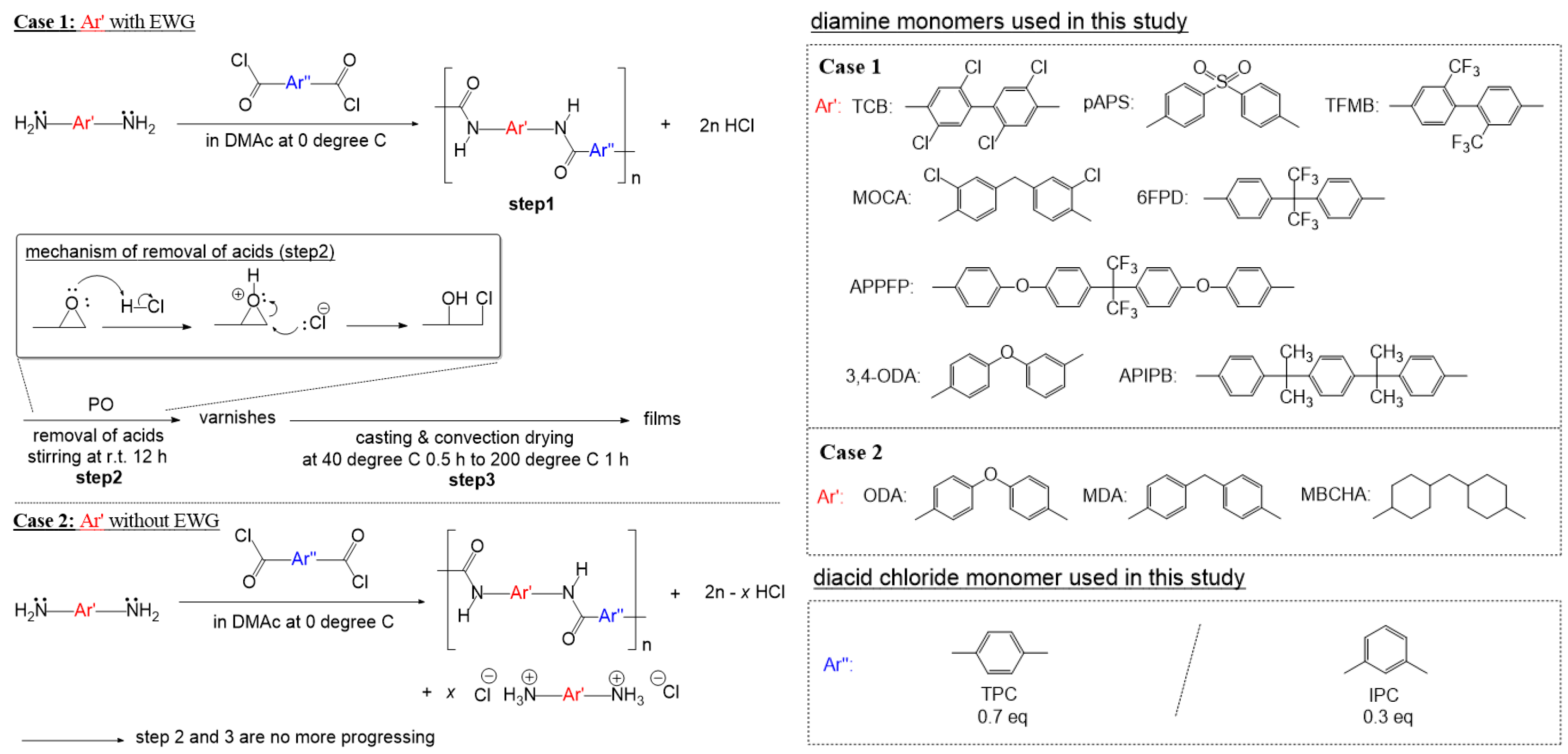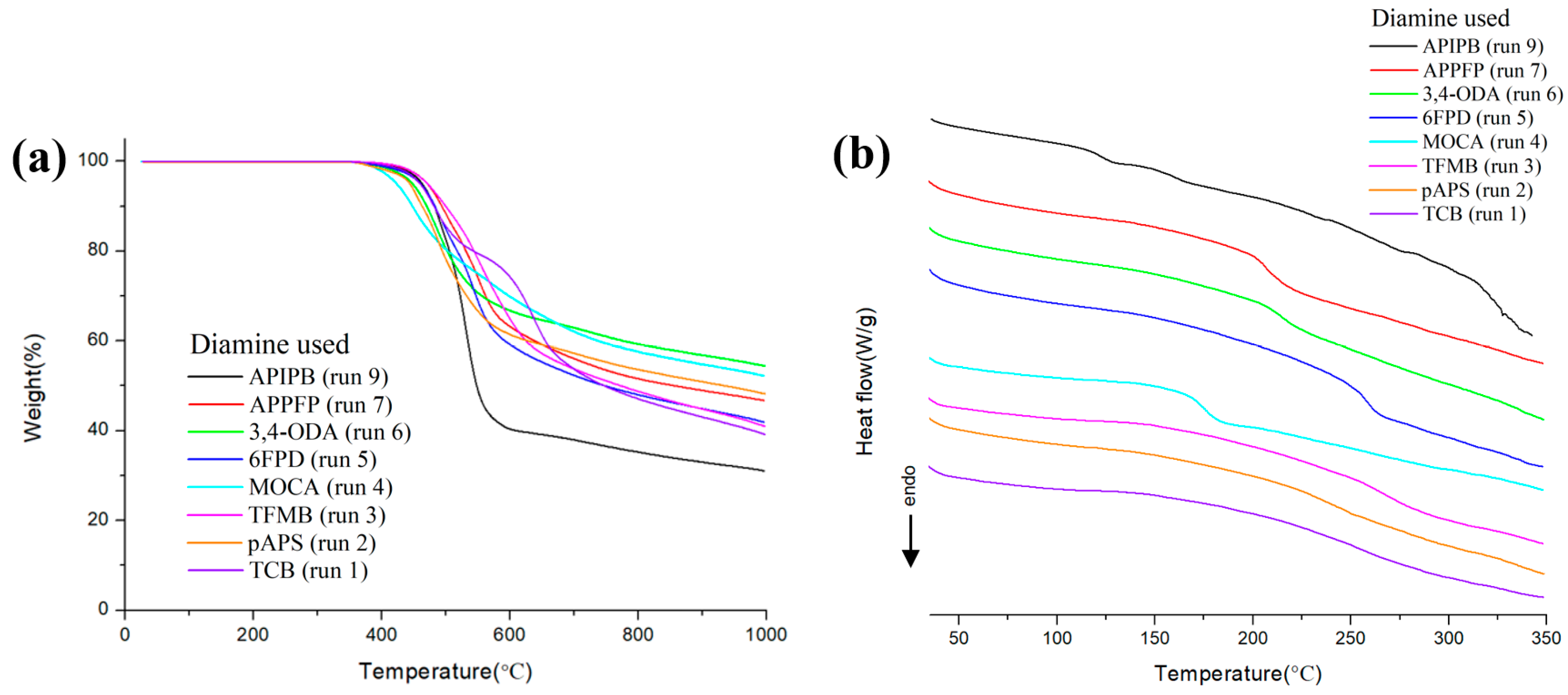Preparation and Properties of Mechanically Robust, Colorless, and Transparent Aramid Films
Abstract
:1. Introduction
2. Materials and Methods
2.1. Materials
2.2. Synthesis of Aramids
2.3. Film Preparation
2.4. Measurements
3. Results and Discussion
3.1. Synthesis of Aramids and Basicity Effect of Diamine Monomers
3.2. Characterization of Aramids
3.3. Thermal Properties of Aramids
3.4. Mechanical Properties of Aramids
3.5. Optical Properties of Aramids
4. Conclusions
Supplementary Materials
Author Contributions
Funding
Institutional Review Board Statement
Data Availability Statement
Conflicts of Interest
References
- García, J.M.; García, F.C.; Serna, F.; de la Peña, J.L. High-performance aromatic polyamides. Prog. Polym. Sci. 2010, 35, 623–686. [Google Scholar] [CrossRef]
- Banerjee, S.; Maji, S. High-performance processable aromatic polyamides. In High Performance Polymers and Engineering Plastics; Scrivener Publishing LLC: Beverly, MA, USA, 2011; pp. 111–166. [Google Scholar]
- Reglero Ruiz, J.A.; Trigo-López, M.; García, F.C.; García, J.M. Functional aromatic polyamides. Polymers 2017, 9, 414. [Google Scholar] [CrossRef] [PubMed]
- Prasad, V.V.; Talupula, S. A review on reinforcement of basalt and aramid (Kevlar 129) fibers. Mater. Today Proc. 2018, 5, 5993–5998. [Google Scholar] [CrossRef]
- Lu, Z.; Dang, W.; Zhao, Y.; Wang, L.; Zhang, M.; Liu, G. Toward high-performance poly(para-phenylene terephthalamide) (PPTA)-based composite paper via hot-pressing: The key role of partial fibrillation and surface activation. RSC Adv. 2017, 7, 7283–7302. [Google Scholar] [CrossRef]
- Cheng, Z.; Liu, Y.; Meng, C.; Dai, Y.; Luo, L. Constructing a weaving structure for aramid fiber by carbon nanotube-based network to simultaneously improve composites interfacial properties and compressive properties. Compos. Sci. Technol. 2019, 182, 107721. [Google Scholar] [CrossRef]
- Murthy, N.S. Hydrogen bonding, mobilitym and structural transitions in aliphatic polyamides. J. Polym. Sci. B Polym. Phys. 2006, 44, 1763–1782. [Google Scholar] [CrossRef]
- Mandal, R.; Maiti, S. Synthesis and characterization of a rigid poly(amide hydrazide): Effect of some reaction parameters on the viscosity of the polymer formed. Polym. Int. 1997, 44, 428–434. [Google Scholar] [CrossRef]
- Harris, F.W.; Zhang, D.; Sun, L.; Jing, J.; Umeda, H.; Okada, J. Aromatic Polyamide Films for Solvent Resistant Flexible Substrates. U.S. Patent US2014/0175683 A1, 26 June 2014. [Google Scholar]
- Sun, L.; Harris, F.W.; Jing, J.; Erdem, H.B.; Harvey, J.D.; Zhang, D. Aromatic Polyamide Films for Transparent Flexible Substrates. U.S. Patent US2017/0022336 A1, 26 January 2017. [Google Scholar]
- Morgan, P.W. Synthesis and properties of aromatic and extended chain polyamides. Macromolecules 1977, 10, 1381–1390. [Google Scholar] [CrossRef]
- Ghosh, K.M.; Mittal, K.L. (Eds.) Synthesis of Polyimides. In Polyimides: Fundamentals and Applications; Marcel Dekker: New York, NY, USA, 1996. [Google Scholar]
- Chae, H.G.; Kumar, S. Rigid-rod polymeric fibers. J. Appl. Polym. Sci. 2006, 100, 791–802. [Google Scholar] [CrossRef]
- Akato, K.; Bhat, G. High Performance Fibers from Aramid Polymers. In Structure and Properties of High-Performance Fibers; Woodhead Publishing: Sawston, UK, 2017; pp. 245–266. [Google Scholar]
- Cosimbescu, L.; Malhotra, D.; Pallaka, M.R.; Swita, M.S. Kevlar-like aramid polymers from mixed PET waste. ACS Omega 2022, 7, 32026–32037. [Google Scholar] [CrossRef] [PubMed]
- Zulfiqar, S.; Ahmad, Z.; Sarwar, M.I. Soluble aromatic polyamide bearing ether linkages: Synthesis and characterization. Colloid Polym. Sci. 2007, 285, 1749–1754. [Google Scholar] [CrossRef]
- Damaceanu, M.D.; Rusu, R.D.; Nicolescu, A.; Bruma, M.; Rusanov, A.L. Organosoluble asymmetric aromatic polyamides bearing pendent phenoxy groups. Polym. Int. 2011, 60, 1248–1258. [Google Scholar] [CrossRef]
- Klein, D.R. (Ed.) Delocalized and Localized Lone Pairs. In Organic Chemistry, 2nd ed.; Wiley: New York, NY, USA, 2013; Section 2.12 in Chapter 2. [Google Scholar]
- Hasegawa, M. Development of solution-processable, optically transparent polyimides with ultra-low linear coefficients of thermal expansion. Polymers 2017, 9, 520. [Google Scholar] [CrossRef] [PubMed]
- Kim, Y.L.; Lee, J.; Kim, H.; Jeon, Y.; Kim, Y.S.; Seong, H.M.; Kwak, G. Mechanically robust and transparent polyamideimide films via consecutive polycondensation, amidation, acid removal, and bluing agent addition. ACS Appl. Polym. Mater. 2022, 4, 9399–9406. [Google Scholar] [CrossRef]
- Kim, H.; Kim, Y.R.; Lee, J.; Lee, H.; Jeon, Y.; Park, S.; Kim, Y.S.; Seong, H.M.; Kwak, G. Highly tough, colorless, transparent polyamide-imide films from one reaction vessel without purification. Macromol. Res. 2023, 31, 213–222. [Google Scholar] [CrossRef]
- Kotov, B.V.; Gordina, T.A.; Voishchev, V.S.; Kolninov, O.V.; Pravednikov, A.N. Aromatic polyimides as charge transfer complexes. Polym. Sci. USSR 1977, 19, 711–716. [Google Scholar] [CrossRef]
- Tsai, C.L.; Yen, H.J.; Liou, G.S. Highly transparent polyimide hybrids for optoelectronic applications. React. Funct. Polym. 2016, 108, 2–30. [Google Scholar] [CrossRef]
- Chen, J.; Liu, C.T. Technology advances in flexible displays and substrates. IEEE Access 2013, 1, 150. [Google Scholar] [CrossRef]






| Polymer Properties | ||||||||||||
|---|---|---|---|---|---|---|---|---|---|---|---|---|
| Run Number | Polymer | Salt Formation 1 | PKa | Viscosity (cP) | Thickness (μm) | Td5% (°C) | Tg 2 (°C) | Young’s Modulus (GPa) | Tensile Strength (MPa) | Elongation at Break (%) | T% at 420 nm | Y.I |
| 1 | TCB | X | 1.58 | 160 | NM | 459 | ND 3 | NM 4 | NM | NM | NM | NM |
| 2 | pAPS | X | 2.41 | 280 | 50 | 443 | 352 5 | 5.26 | 52.60 | 11.78 | 91.28 | 4.34 |
| 3 | TFMB | X | 3.23 | 2520 | 50 | 470 | 339 5 | 8.15 | 118.90 | 5.93 | 95.13 | 2.37 |
| 4 | MOCA | X | 3.33 | 1060 | 60 | 424 | 176 | 4.95 | 107.84 | 11.58 | 71.87 | 10.94 |
| 5 | 6FPD | X | 3.98 | 340 | 60 | 461 | 257 | 5.07 | 82.97 | 5.62 | 96.24 | 1.91 |
| 6 | 3,4-ODA | X | 4.78 | 350 | 50 | 447 | 214 | 7.58 | 99.98 | 23.96 | 54.51 | 17.03 |
| 7 | APPFP | X | 4.80 | 1810 | 60 | 472 | 207 | 4.07 | 81.38 | 37.68 | 79.34 | 9.56 |
| 8 | ODA | O | 5.20 | - | - | - | - | - | - | - | - | - |
| 9 | APIPB | X | 5.31 | 820 | 60 | 463 | 121 | 4.76 | 89.60 | 3.14 | 85.50 | 7.16 |
| 10 | MDA | O | 5.32 | - | - | - | - | - | - | - | - | - |
| 11 | MBCHA | O | 10.97 | - | - | - | - | - | - | - | - | - |
| Solvent | Aramids, Diamine Used (Run Number in Table 1) | |||||||
|---|---|---|---|---|---|---|---|---|
| (δ, Mpa1/2) 2 | TCB (Run 1) | pAPS (Run 2) | TFMB (Run 3) | MOCA (Run 4) | 6FPD (Run 5) | 3,4-ODA (Run 6) | APPFP (Run 7) | APIPB (Run 9) |
| DMAc (22.8) | + | + | + | + | + | + | + | + |
| NMP (23.0) | + | + | + | + | + | + | + | − |
| DMSO (26.7) | + | + | − | + | + | + | + | ± |
| Acetone (20.0) | − | − | ± | − | ± | − | − | − |
| THF (19.4) | − | − | − | − | − | − | ± | − |
| Chloroform (19.0) | − | − | − | − | − | − | − | − |
| Toluene (18.2) | − | − | − | − | − | − | − | − |
| Methanol (29.7) | − | − | − | − | − | − | − | − |
Disclaimer/Publisher’s Note: The statements, opinions and data contained in all publications are solely those of the individual author(s) and contributor(s) and not of MDPI and/or the editor(s). MDPI and/or the editor(s) disclaim responsibility for any injury to people or property resulting from any ideas, methods, instructions or products referred to in the content. |
© 2024 by the authors. Licensee MDPI, Basel, Switzerland. This article is an open access article distributed under the terms and conditions of the Creative Commons Attribution (CC BY) license (https://creativecommons.org/licenses/by/4.0/).
Share and Cite
Kim, H.; Noh, J.-H.; Kim, Y.-R.; Kim, H.; Kwak, G. Preparation and Properties of Mechanically Robust, Colorless, and Transparent Aramid Films. Polymers 2024, 16, 575. https://doi.org/10.3390/polym16050575
Kim H, Noh J-H, Kim Y-R, Kim H, Kwak G. Preparation and Properties of Mechanically Robust, Colorless, and Transparent Aramid Films. Polymers. 2024; 16(5):575. https://doi.org/10.3390/polym16050575
Chicago/Turabian StyleKim, Heesang, Jin-Hee Noh, Young-Rae Kim, Hyojin Kim, and Giseop Kwak. 2024. "Preparation and Properties of Mechanically Robust, Colorless, and Transparent Aramid Films" Polymers 16, no. 5: 575. https://doi.org/10.3390/polym16050575





